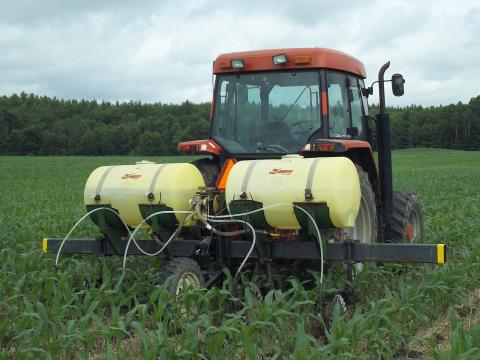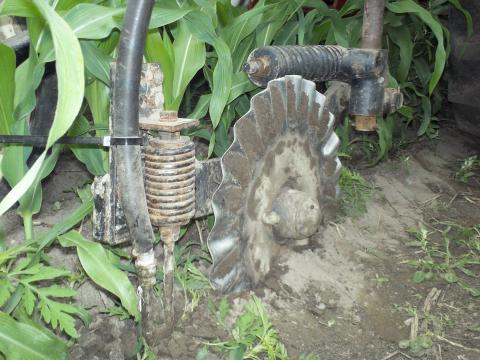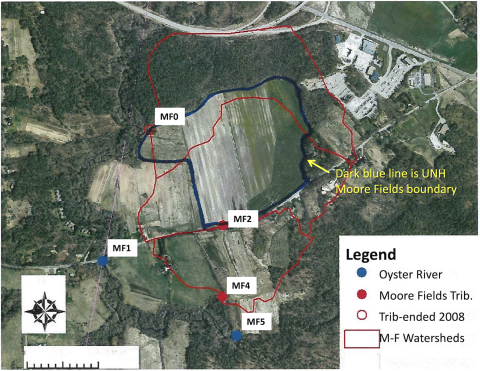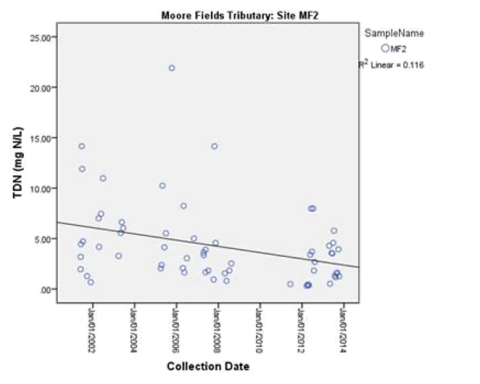Thompson Farm
This 205-acre farm consists of forest, hayfields and tillable land used for forage and corn silage production. Cropping is managed by the Farm Services unit. Because it possesses characteristics that are unique in the Durham area (e.g., distance from roads and vehicular traffic, open fields, etc.), this farm was chosen as the site for a NOAA AirMap Station, part of a national network of stations which is collecting continuous data on a large number of air quality measures. Several holding tanks have been located at this farm in support of research on amphibians.
Access through the West Foss Farm:
Take Mill Road south until you reach the bridge that goes over railroad tracks. Take the immediate left over bridge onto a dirt road. After the gate and down the dirt road, will bring you through the Foss Farm and onto the Thompson Farm.
Access through the Highland House Property:
Take Mill Road south to Packers Falls Road. Take a left onto Packers Falls and stay on road until you reach Bennett Road. At the Highland House property is the Thompson Farm.
Moore Field
The Moore Field includes about 90 acres of cropland plus adjacent woodlands, 1.5 miles from campus off highway 155A toward Lee. Its primary use is for research and feed production. It also provides open habitat for many species of birds. Originally called the Moore Lot, it was given by Eugene L. Moore in 1941. At that time the property was forested and extensive timber harvesting activities occurred throughout the 1960’s until it was converted to agricultural land.
Take Mast Road, RT155A out of Durham towards Lee. After you pass the UNH Sawmill on your left, the Moore Fields property is the large field complex on your right. The woodlot is behind these fields and just south of Route 4. Contact the Woodlands office for access through the chained gate. If you park along the road please don’t block the gates.
Sustainable field Management Practices
In addition to managing five research farms, dairies, and greenhouses, the NH Agricultural Experiment Station supports several fields that contribute to the operations and success of our scientists, graduate and undergraduate student training, and our community's recreational and related opportunities. Several of the fields are used to produce hay and corn crops—with conventional and organic production approaches—that are used as feed for the approximately 300 dairy cows at the university's research and teaching dairies and approximately 30 horses at the UNH equine facility.
The NHAES staff is committed to ensuring that the management of our agricultural operations follows best practices and scientifically sound guidance to assure the joint goals of animal feed production for our agricultural research endeavors and environmental sustainability related to feed production activities. The answers to these frequently asked questions provide more details about our sustainable field management practices.
What does the management of fields entail?
Sustainable field management is a multi-year, production portfolio approach in which different crops are planted on different fields in different years (crop rotations) to ensure that we are able to maintain a level of soil quality and productivity. Depending on this management plan, a field is prepared for seeding, crops are seeded with that year's prescribed crop in the spring, fertilizer is applied, the crop is harvested (once per season for corn and several times per season for hay), and transported to be stored at the animal facilities.
Why do crops need to be fertilized?
Plants require nutrients to grow. There are three key nutrients—nitrogen, phosphorous, and potassium—and numerous other micronutrients that are used by a plant. Grasses—such as corn, other types used for hay production, and even those that grow in your lawn—require substantial amounts of nitrogen and a lower amount of phosphorous and potassium.
What do you use as fertilizer?
The UNH field management plan includes the use of animal manure as its fertilizer source. Manure is a common source of plant nutrients in the United States and the world, particularly for those agricultural uses that are near manure sources.
Why do UNH field operations use animal manure as fertilizer?
Within the set of NH Agricultural Experiment Station's facilities, this represents a sustainable, industry-representative approach. As animals on the NHAES farms produce manure, rather than removing it completely, the manure is cycled back into crop production as fertilizer. This aids in achieving higher sustainability in two ways. (1) Environmental and economic costs of trucking the waste off-site are significantly reduced. (2) Environmental and economic costs of purchasing and trucking synthetic fertilizer to NHAES farms do not exist.
Additionally, the organic solids in manure are highly beneficial to building and maintaining soil tilth (soil health). And, it ensures that we are able to maintain organic certification for feed production that goes to our organic dairy. If you eat organic foods, you support manure fertilization.
Lastly, the practice is typical of commercial operations throughout New Hampshire and other New England states. This ensures that research at the NH Agricultural Experiment Station accurately takes into account relevant practices in the region in order to develop insights that are useful and applicable to our state's food production sectors.
What information is used to determine how much fertilizer to apply?
We base our manure applications on a nutrient balance of three factors: (1) how much nutrient concentration already exists in the soil (measured using soil tests); (2) how much the predicted crop nutrient requirements are; and (3) the concentration of nutrients in the manure. The application rates are analogous to balancing a budget: the nutrients that went out as a result of previous production must be replenished.
Are concentrations of nitrogen high in manure fertilizer?
Analytical lab measurements of nitrogen concentration in liquid manure from the dairy and equine facilities are 0.23% and 0.28%, respectively. For comparison, typical synthetic fertilizers placed on home lawns have nitrogen concentrations ranging from 10% to 25%. As such, the manure provides between 0.01 and 0.03 percent of nitrogen concentration when compared to common other fertilizer products.
Does UNH have a nutrient management plan?
Yes! Our farm leadership staff has worked with the USDA Natural Resources Conservation Services State Agronomist to develop a sustainable nutrient management plan. Our goal is for our operations to be a model for sustainably stewarding agricultural land, especially near population centers.
Can the applied nitrogen leak into the water supply?
Yes. There are three main ways that this can happen. (1) If nitrogen concentration in the soil is too high and is unused by the plants, the remaining nitrogen can filter into ground water. (2) If there is an unexpected and heavy rain event shortly after fertilizer application. (3) If fertilizer is applied to heavily frozen soils that cannot absorb the nutrients.
How do the sustainable field management practices minimize the risk of fertilizer leaks?
(1) Soil testing for nutrient concentration: our farm operations staff consistently and regularly tests our field soils to ensure that they are within the levels specified in the UNH Nutrient Management Plan.


Fertilizer is dripped into disced soil
(2) Minimize time at soil surface: we ensure that any application of fertilizer is done to spend as little time at the surface as possible. For fertilizer applied before seeding, the manure is incorporated into the soil within 2 hours of application by an implement that discs the fertilizer into the ground. For fertilizer applied after crops have emerged, manure is dripped into row slices below the soil surface to minimize damage to the crops.
(3) Do not fertilize frozen soil: we do not apply manure to soils that have frozen to such an extent as to impede the 8-inch rotating discs that create the soil slice for dripping fertilizer. Once the soil freezes, we inventory solid manure until spring. It is important to note that soils are highly efficient in keeping heat, ensuring that there is a strong buffer for the rate at which soil freezes from the top layer (when air temperature may be below freezing) to lower soil layers. When there is a frost or even several frosts, soil does not freeze other than the very top surface (this is similar to a pond). The frozen soil surface layer often thaws during the day.
Have there been efforts to monitor water quality to ensure that the sustainable field management practices are sufficient?
Yes. UNH scientists have monitored surface water nutrient and chemical concentrations for more than a decade. This process is completely independent of our agricultural operations, ensuring that the collected data are free of conflicts of interest. The map below shows the watersheds and water quality sampling locations at Moore Fields.

MF represent the water sampling locations
On the back (west) edge of Moore Fields, a diversion ditch was created to route runoff water coming from the adjacent woodlands, UNH West Edge parking lot, and The Lodges development areas away from the agricultural land. The ditch collects very little water from the fields themselves due to the topography of the land and buried drainage pipes that are directed toward Mast Road. As such, the ditch does not represent nutrients or salinity coming from the agricultural operations.
Collected water quality data from the sampling site that is most closely associated with the agricultural operation (MF2 in the above map) indicate that there continues to be a decrease in nitrogen concentration levels over time.

Sampled water quality data from site MF2, 2002–2014
Getting Here
Contact
Thompson Farm
Steve Eisenhaure
Phone: (603) 862-3951
Moore Field
Peter Davis
Phone: (603) 862-1169
Rt. 155A
Durham, NH 03824
United States